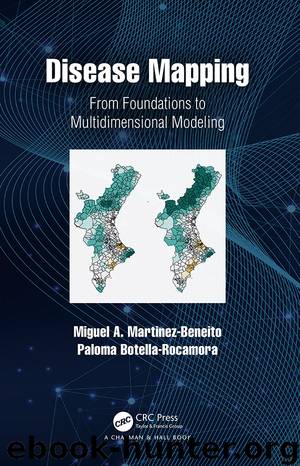Disease Mapping by Martinez-Beneito Miguel A.; Botella-Rocamora Paloma;

Author:Martinez-Beneito, Miguel A.; Botella-Rocamora, Paloma;
Language: eng
Format: epub
Publisher: CRC Press LLC
Published: 2019-06-16T16:00:00+00:00
Figure 5.2
First three non-zero eigenvectors of the precision matrix of an ICAR distribution (D − W) on the Valencian Region. Light, respectively dark, municipalities stand for negatives values, respectively positive, of the corresponding eigenvector.
Once we have an intuition on when to expect important confounding issues in ecological regression, we wonder now, what is the expected effect of spatial confounding on β1’s estimation? Spatial confounding is the effect of the collinearity of x and some of the eigenvectors of D − W, which are a basis for the linear space where ψ takes values. Collinearity, in general, makes the variances of estimates inflated, so this is the main effect that we would expect to notice on β1’s posterior distribution when the corresponding model contains a spatial random effect. Indeed if ψ was not smoothed at all ( was infinite), this would make the posterior variance of β1 become infinite, making that value unidentifiable. Therefore, in the specific case of the Valencian Region, we would expect that introducing a spatial random effect into the ecological regression model would increase β1 posterior variance, particularly if x varied mainly from north to south. This variance inflation will alleviate the effect of overdispersion, which made us find much more significant results in Example 5.1 than we ought, achieving in principle more reasonable results.
Beyond variance inflation, Hodges and Reich (2010) show that including spatial random effects in ecological regression studies also produces some bias in β1’s estimate. Specifically, they show that including random effects in ecological regressions also modifies β1’s estimate, although in an unknown direction. That is, if and corresponded to the posterior mode of the effect of x in a Poisson regression model with and without, respectively, random effects then could be either lower or higher than , depending on the specific data at hand. As a consequence, introducing random effects into ecological regression models does not necessarily have either a reducing or amplifying effect on β1’s estimation, on the contrary its effect could be qualified as haphazard. Richardson (2003) also reaches this conclusion from a more empirical point of view in contrast to, for example, Clayton et al. (1993) who qualifies introducing spatial random effects into ecological regression models as a dilution of the effect of the covariate. Additionally, Hodges and Reich show that if no further covariate besides x had an influence on the distribution of the relative risks, the spatial random effects would modify even though it was not required, which seems an unpleasant performance that we would like to avoid.
Our goal when dealing with confounding would be to avoid the effect (bias) of ψ on while fitting for overdispersion and spatial dependence in the data. For achieving this goal in Gaussian ecological regression models, Reich et al. (2006) propose to impose ψ to be orthogonal to the covariate x. This restriction, when applied to the intercept term, is equivalent to the frequently assumed sum-to-zero restriction on ψ that allows us to identify the effect of the intercept in the linear term of the BYM model.
Download
This site does not store any files on its server. We only index and link to content provided by other sites. Please contact the content providers to delete copyright contents if any and email us, we'll remove relevant links or contents immediately.
Sass and Compass in Action by Wynn Netherland Nathan Weizenbaum Chris Eppstein Brandon Mathis(7399)
Drawing Shortcuts: Developing Quick Drawing Skills Using Today's Technology by Leggitt Jim(2529)
Hands-On Unity 2022 Game Development by Nicolas Alejandro Borromeo(2445)
The 46 Rules of Genius: An Innovator's Guide to Creativity (Voices That Matter) by Marty Neumeier(2306)
Autodesk Civil 3D 2024 from Start to Finish by Stephen Walz Tony Sabat(2205)
Rapid Viz: A New Method for the Rapid Visualization of Ideas by Kurt Hanks & Larry Belliston(2190)
Learn Qt 5: Build modern, responsive cross-platform desktop applications with Qt, C++, and QML by Nicholas Sherriff(2173)
Mathematics for Game Programming and Computer Graphics by Penny de Byl(2106)
Fusion 360 for Makers by Lydia Sloan Cline(1985)
Hands-On Neural Networks with Keras by Niloy Purkait(1868)
Taking Blender to the Next Level by Ruan Lotter(1786)
Express Your Creativity with Adobe Express by Rosie Sue(1755)
Mastering GUI Programming with Python by Alan D. Moore(1750)
Game Physics Cookbook by Gabor Szauer(1573)
Creative Character Design by Bryan Tillman(1556)
Unreal Engine 4 Game Development Quick Start Guide by Rachel Cordone(1422)
Hands-On GUI Application Development in Go by Andrew Williams(1415)
Qt 5 and OpenCV 4 Computer Vision Projects by Zhuo Qingliang(1398)
Mastering Graphics Programming with Vulkan by Marco Castorina | Gabriel Sassone(1374)
